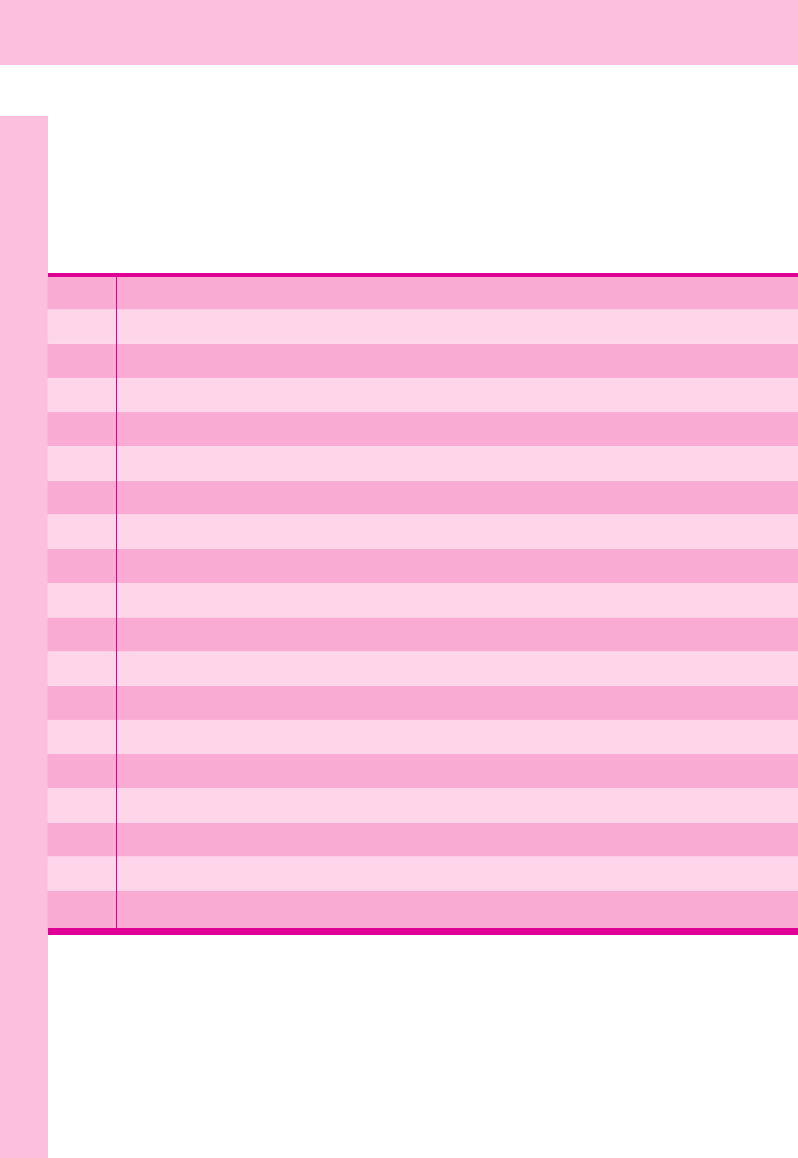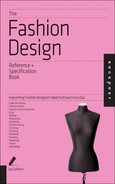
Job:12-29742 Title:RP-Fashion Design Ref and Spec Book
#175 Dtp:204 Page:10
001-019.indd 10 2/26/13 7:10 PM
10 THE FASHION DESIGN REFERENCE + SPECIFICATION BOOK
(Text)
Chapter 1: Evaluation
To say that the eld of fashion design is highly competitive is a tremendous
understatement. The fashion centers of New York, Paris, and Milan lead the
industry, but are by no means the only places where a designer can pursue a
career. Every major city now seems to have a regional pool of style makers, fash-
ion design schools, and local fashion weeks. Do-it-yourself programs, classes,
books, and magazines provide just enough of what someone might need to feel
like an authentic fashionista. Reality television shows and unlimited access to
information on the Internet also add to the mix of aspiring designers.
In the celebrity-driven culture that the fashion industry feeds, any inkling of tal-
ent will often be blown out of proportion. This exposure affords new designers
with their coveted fteen minutes of fame, but also robs them of the opportu-
nity to fully develop their message and their craft. They are immediately tested
by demanding consumers and media outlets moving at lightning speed. To
survive depends on an understanding of how the system works and a healthy
skepticism of their own press. In the long term, building a successful career as
a fashion designer requires much more than making beautiful, well-constructed
clothes. That’s merely the price to play.
A good designer can create anything with suf cient research and a clear aware-
ness of the design challenge being undertaken. A great designer does more.
The Pareto principle describes a law of the vital few, where 80 percent of the
effects result from 20 percent of the causes. In fashion, this small but essen-
tial core is the spark that sets things into motion. Visionary, unique, inspired,
ahead of their time: Theirs are big shoes to ll, even when designers feel that
they, too, have something to contribute.
The bad news is that when it comes to clothing the human body most every-
thing has been done before. The good news is that it hasn’t been done by each
new designer. Why this should matter to anyone else is a tough question that
demands a response full of meaning, purpose, and con dence; otherwise it
just gets lost in the sea of options that ood the fashion marketplace every
year. To truly grasp what one stands for both personally and as a designer will
infuse one’s work with passion and one’s message with clarity.
T
T
t
h
N
Ev
of
d
a
a
L
A
p
th
b
h
of
In
A
in
b
to
D
L
m
a
t
fo
cr
01
Job:12-29742 Title:RP-Fashion Design Ref and Spec Book
#175 Dtp:204 Page:10
001-019.indd 10 2/26/13 7:11 PM

Job:12-29742 Title:RP-Fashion Design Ref and Spec Book
#175 Dtp:204 Page:11
Book
ge:10
001-019.indd 11 2/26/13 7:10 PM
11
(Text)
THE INDIVIDUAL DESIGNER
The first step is for designers to establish—with absolute honesty—what they bring to
the table.
Natural Talents
Eve r y o n e h a s g i f t s . Ha vi n g a a i r f o r f a s h i o n o r a n i n s t i n ct f o r d e s i g n i s n o t a l w a y s a n i n d i ca t o r
o f a g o o d f a s h i o n d e s i g n e r , n o r i s i t a p r e r e qu i s i t e . An i n h e r e n t a f n i t y f o r a n y n u mb e r o f o t h e r
d i s ci p l i n e s , s u ch a s ma t h , s ci e n ce , o r s p o r t s , ma y p r o vi d e a s g o o d a b a s e t o b u i l d o n a s a n
a r t -r e l a t e d f o u n d a t i o n . Wi t h o r w i t h o u t a n i n n a t e a p t i t u d e f o r f a s h i o n , cu r i o s i t y , d e d i ca t i o n ,
a n d t h e o cca s i o n a l l e a p o f f a i t h a r e ma r ke r s o f t h e p o t e n t i a l f o r s u cce s s i n t h e e l d .
Learned Skills
An y o n e ca n a cqu i r e p r o ci e n cy i n a n a ct i vi t y , g i ve n e n o u g h t i me a n d e f f o r t . Fa s h i o n e n co m-
p a s s e s a va s t r a n g e o f s p e ci a l t i e s , e a ch w i t h i t s o w n t e ch n i qu e s a n d s e t o f s ki l l s . By h o n i n g
t h e s e s ki l l s , d e s i g n e r s e s t a b l i s h a u e n cy a n d i mme d i a t e r e ca l l i n t h e w o r kp l a ce . No t h i n g
b e a t s a ct u a l e xp e r i e n ce . T h r o u g h cl a s s e s , w o r ks h o p s , a n d i n t e r n s h i p s d e s i g n e r s ca n b u i l d
h a n d -t o -e y e co o r d i n a t i o n , l e a r n t o a n t i ci p a t e p r o b l e ms , a n d a d d r e s s t h e p a r t i cu l a r ch a l l e n g e s
o f e xe cu t i n g t h e i r i d e a s .
Interpersonal Intelligence
As d e s i g n e r s g a i n a cl e a r p i ct u r e o f w h a t t h e y w a n t t o a cco mp l i s h , t h e y mu s t b e a ct i ve l y l i s t e n -
i n g a n d o b s e r vi n g t h e n o n ve r b a l cu e s t o t h e n e e d s a n d d e s i r e s o f o t h e r s . Su ch a t t e n t i o n w i l l
b e t t e r e qu i p d e s i g n e r s t o ma n a g e r e l a t i o n s h i p s w i t h i n a d e s i g n t e a m o r w i t h ve n d o r s , s a y , a n d
t o p e r s u a d e o t h e r s t o ma ke co n ce s s i o n s i n t h e n a me o f co l l a b o r a t i o n .
Defining Success
Li ke a n y cr e a t i ve e n d e a vo r , f a s h i o n i s d e ma n d i n g a n d r e g u l a r l y t e s t s t h e r e s o l ve . De s i g n e r s
mu s t u n d e r s t a n d t h e i r p r i ma r y mo t i va t i o n f o r p u r s u i n g a ca r e e r i n f a s h i o n , w h e t h e r f a me ,
n a n ci a l r e w a r d , cr i t i ca l s u cce s s , o r t o l l a vo i d i n t h e ma r ke t . A ve n t u r e t h a t n e e d s t o g e n e r -
a t e a p r o t a s w e l l a s a ccl a i m p r e s e n t s ce r t a i n r e a l i t i e s . A d e s i g n e r ma y w a n t t o b e r e s p e ct e d
f o r a r t i s t i c co n t r i b u t i o n s t o t h e e l d b u t ca n ’t a vo i d t h e b o t t o m l i n e . Pr i o r i t i zi n g g o a l s e a r l y o n
cr e a t e s a t o u ch s t o n e f o r e ve r y s t a g e o f t h e d e s i g n p r o ce s s .
01
Job:12-29742 Title:RP-Fashion Design Ref and Spec Book
#175 Dtp:204 Page:11
Book
ge:10
001-019.indd 11 2/26/13 7:11 PM

Job:12-29742 Title:RP-Fashion Design Ref and Spec Book
#175 Dtp:204 Page:12
001-019.indd 12 2/26/13 7:10 PM
12 THE FASHION DESIGN REFERENCE + SPECIFICATION BOOK
(Text)
STARTER QUESTIONS
Well-crafted questions will help fashion designers identify and quantify their existing talents
and skills, as well as determine how they work with people, how they de ne success, and
how they tap into their creativity. These questions can be exciting, thought provoking, and
sometimes intimidating. Designers should approach their answers as baselines rather than as
judgments of the validity of their path.
Why do I want to be a fashion designer?
What inspires me?
Do I have a grasp on fashion history?
What training do I have?
Do I know how garments are constructed?
Do I have an understanding of textiles?
What is my industry experience?
What specialized area of fashion interests me?
Have I committed to a professional career path?
What are my business skills?
Am I comfortable with technology?
Can I adhere to timelines?
Am I good with people?
Where do I plan on working?
Who are my industry role models?
When will I start my next project?
How will I maintain fit and quality standards?
How large a body of work have I built?
How do I plan to continue learning?
Armed with a better idea of the areas in which they are competent, fall short, or excel, design-
ers must next take action to protect the environments that allow their innate gifts to ourish
and expose themselves to a wide variety of places and situations that inspire and afford them
opportunity. At each step, designers’ understanding of who they are within the eld of fashion
will broaden.
T
D
a
d
co
A
n
te
D
u
in
fu
a
C
o
m
e
co
h
M
D
ta
w
le
d
b
H
p
w
vi
it
01
Job:12-29742 Title:RP-Fashion Design Ref and Spec Book
#175 Dtp:204 Page:12
001-019.indd 12 2/26/13 7:11 PM

Book
ge:12
Job:12-29742 Title:RP-Fashion Design Ref and Spec Book
#175 Dtp:204 Page:13
001-019.indd 13 2/26/13 7:10 PM
Evaluation 13
(Text)
s
-
m
n
THE DESIGN TEAM
Designers must decide which skills will become an integral part of their own design process
and which will be better handled by individuals for whom it is second nature. In building a
design team, designers should seek out and surround themselves with people whose skills
complement their own, whether in the category of sewing techniques or business models, say.
Always strive to attract the very best talent available. Good designers are also leaders who will
not hesitate to hire someone who is better than they are in a particular arena. Well-balanced
teams allow individual members to concentrate their efforts on their part of the process.
Designers should regularly update the biographies and/or résumés of the entire team. A good
understanding not only of their backgrounds, but also both their professional and personal
interests, allows designers to engage team members creatively in their vision. Individuals who
function as an extension of the designer’s skill set can be focused on specific components of
any project, enabling them to take it further on behalf of the designer.
Classes, workshops, lectures, and special fashion events provide designers with numerous
opportunities for connecting with experts and peers from whom to build a team. Designers
must be prepared for each encounter: Know how to present an identity with enough detail to
entice, and yet concisely so as not to bore. Observe behavior and listen carefully for valuable
content. Discreetly and casually collect contact information and follow up once the encounter
has been processed.
MENTOR MATCHING
Designers can benefit enormously from finding a mentor. Learning can come from both es-
tablished fashion professionals and from peers who are making strides in areas the designer
wishes to engage. For anyone going to the trouble of reaching out for this kind of support, a
level of humility and active listening are essential. Situations might arise in which the designer
disagrees with the advice being shared. But competing to make one’s point negates the full
benefit of what a mentor may provide.
Hero worship is a different thing all together, because it is based on the myth surrounding a
person rather than the facts. Those facts are simple: What decisions has a designer made,
what were the results, and how have they stood the test of time? Historical and contemporary
visionaries often become bigger than life within the context of one’s daily experience. In fact,
it is sum of their choices to which the designer responds and aspires.
01
Book
ge:12
Job:12-29742 Title:RP-Fashion Design Ref and Spec Book
#175 Dtp:204 Page:13
001-019.indd 13 2/26/13 7:11 PM

Job:12-29742 Title:RP-Fashion Design Ref and Spec Book
#175 Dtp:204 Page:14
001-019.indd 14 2/26/13 7:10 PM
14 THE FASHION DESIGN REFERENCE + SPECIFICATION BOOK
(Text)
TOOLS AND MATERIALS
Especially when starting out, designers must determine the tools and materials needed for
their work. This inventory has a monetary value; but more important, it has a direct effect on
how a designer will choose to execute an idea.
Money obviously allows for smoother and more seamless operations. The level of access to
funding for any project can pose different types of challenges, yet a creative approach can nd
ways to stretch the effectiveness of any budget. Designers must constantly decide where they
will make sacri ces and where they will not compromise.
T
co
a
ti
M
A
p
sa
Photographs by Tracy Aiguier.
01
Job:12-29742 Title:RP-Fashion Design Ref and Spec Book
#175 Dtp:204 Page:14
001-019.indd 14 2/26/13 7:11 PM
..................Content has been hidden....................
You can't read the all page of ebook, please click here login for view all page.
